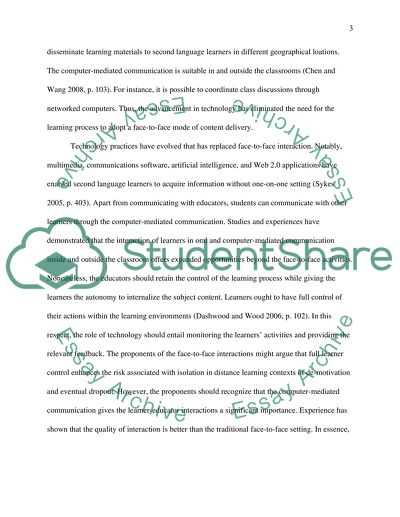Cite this document
(“Saville-Troike (2012) claims that face-to-face interaction is not Essay”, n.d.)
Saville-Troike (2012) claims that face-to-face interaction is not Essay. Retrieved from https://studentshare.org/education/1669993-saville-troike-2012-claims-that-face-to-face-interaction-is-not-absolutely-necessary-for-second-language-acquisition-what-do-you-think-support-or-refute-the-claim-based-on-your-own-experience-and-with-reference-to-relevant-aspects-of-sla-theory
Saville-Troike (2012) claims that face-to-face interaction is not Essay. Retrieved from https://studentshare.org/education/1669993-saville-troike-2012-claims-that-face-to-face-interaction-is-not-absolutely-necessary-for-second-language-acquisition-what-do-you-think-support-or-refute-the-claim-based-on-your-own-experience-and-with-reference-to-relevant-aspects-of-sla-theory
(Saville-Troike (2012) Claims That Face-to-Face Interaction Is Not Essay)
Saville-Troike (2012) Claims That Face-to-Face Interaction Is Not Essay. https://studentshare.org/education/1669993-saville-troike-2012-claims-that-face-to-face-interaction-is-not-absolutely-necessary-for-second-language-acquisition-what-do-you-think-support-or-refute-the-claim-based-on-your-own-experience-and-with-reference-to-relevant-aspects-of-sla-theory.
Saville-Troike (2012) Claims That Face-to-Face Interaction Is Not Essay. https://studentshare.org/education/1669993-saville-troike-2012-claims-that-face-to-face-interaction-is-not-absolutely-necessary-for-second-language-acquisition-what-do-you-think-support-or-refute-the-claim-based-on-your-own-experience-and-with-reference-to-relevant-aspects-of-sla-theory.
“Saville-Troike (2012) Claims That Face-to-Face Interaction Is Not Essay”, n.d. https://studentshare.org/education/1669993-saville-troike-2012-claims-that-face-to-face-interaction-is-not-absolutely-necessary-for-second-language-acquisition-what-do-you-think-support-or-refute-the-claim-based-on-your-own-experience-and-with-reference-to-relevant-aspects-of-sla-theory.


